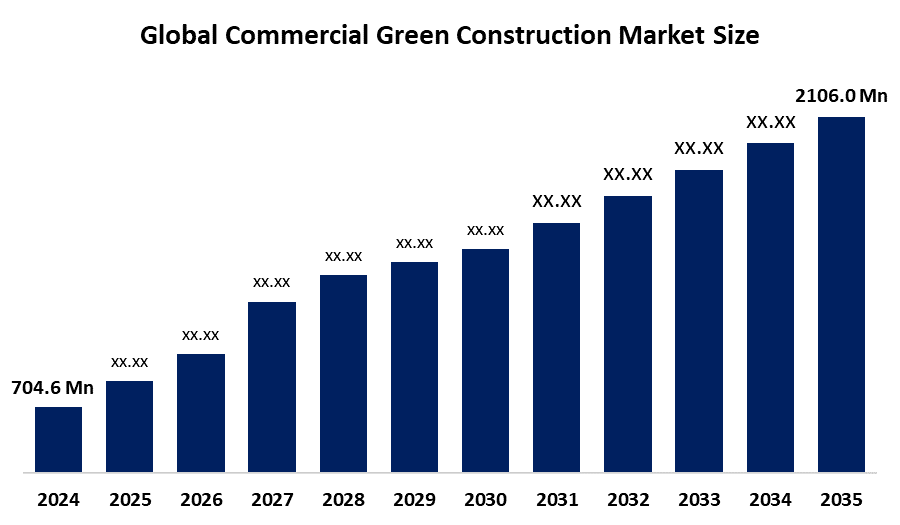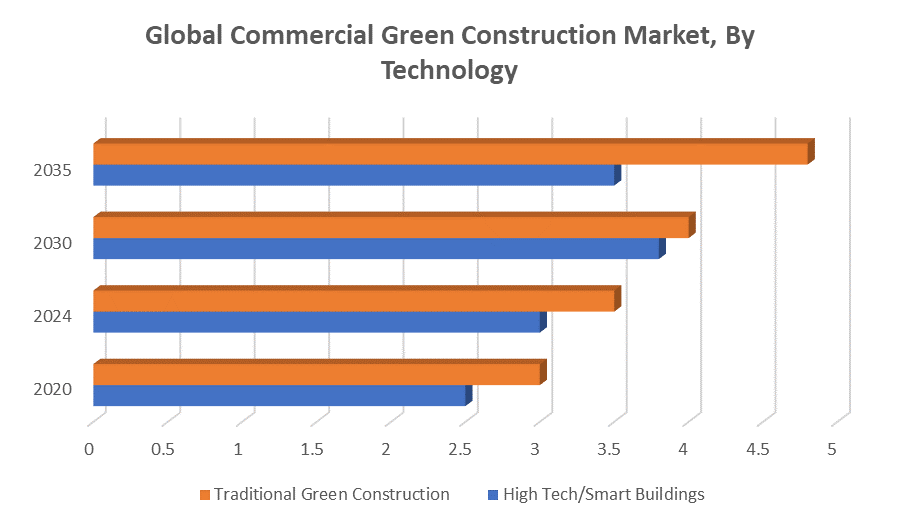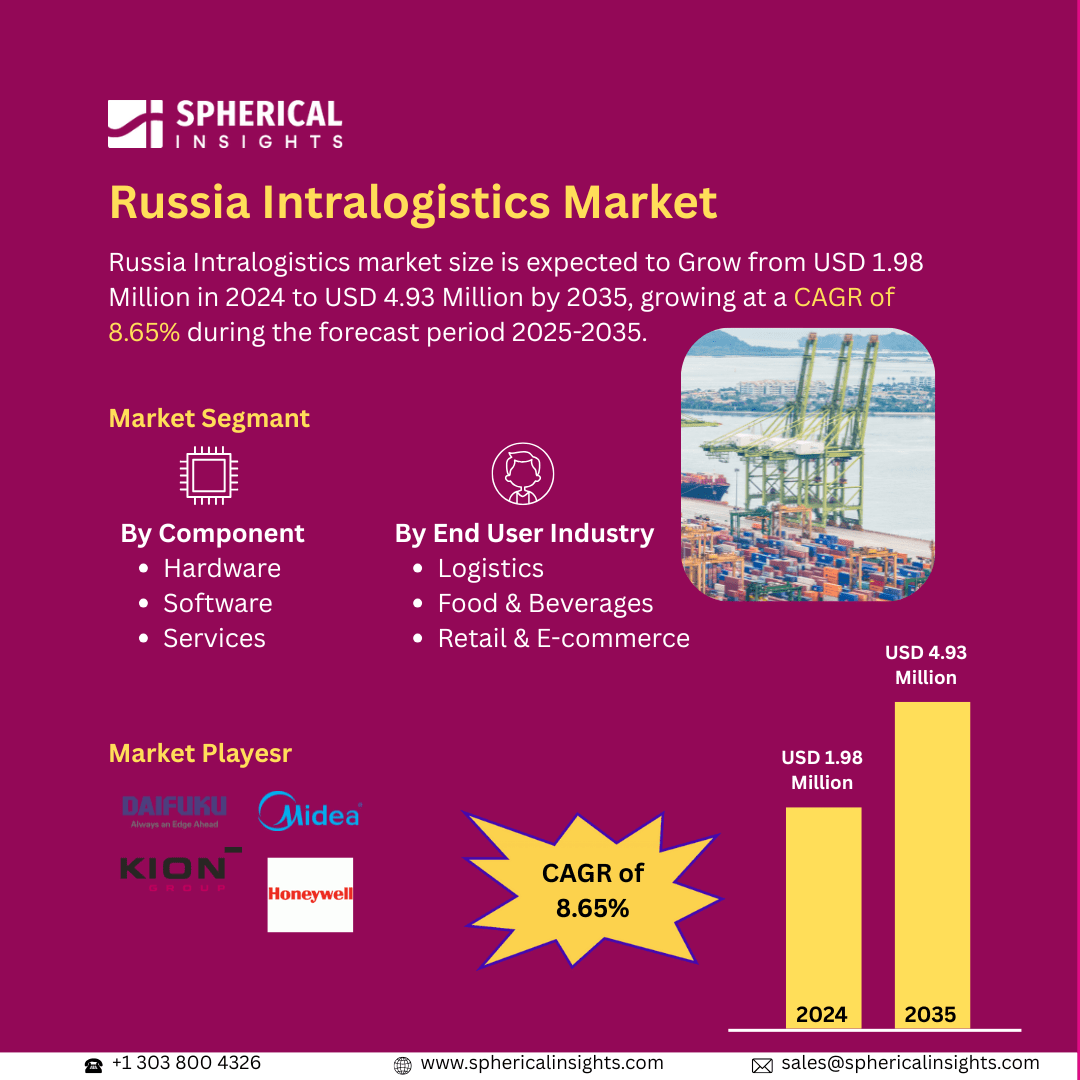Global Commercial Green Construction Market Insights Forecasts to 2035
- The Global Commercial Green Construction Market Size Was Estimated at USD 704.6 Million in 2024
- The Market Size is Expected to Grow at a CAGR of around 10.47% from 2025 to 2035
- The Worldwide Commercial Green Construction Market Size is Expected to Reach USD 2106.0 Million by 2035
- Latin America is expected to grow the fastest during the forecast period.

Commercial Green Construction Market
The Global Commercial Green Construction Market Size refers to the sector focused on creating energy-efficient, environmentally friendly, and sustainable buildings for commercial use. This market has seen significant growth due to increasing awareness of climate change, the need for energy conservation, and advancements in green technologies. Green construction emphasizes the use of sustainable materials, energy-efficient systems, and design strategies that reduce the carbon footprint of buildings. It incorporates renewable energy sources like solar and wind power, water conservation techniques, and waste management practices. Additionally, the market benefits from government regulations and incentives promoting sustainable building practices. The commercial green construction market encompasses various segments, including office buildings, retail spaces, industrial facilities, and institutional buildings. With rising environmental concerns, the demand for eco-friendly construction is expected to continue to grow, driving innovations in building materials, technologies, and design approaches to meet sustainability standards globally.
Attractive Opportunities in the Commercial Green Construction Market
- Growing urbanization in emerging economies is driving strong demand for new commercial infrastructure. This allows green construction to be integrated from the outset, making sustainability a standard practice in these fast-developing regions.
- The adoption of IoT sensors, AI-driven energy management systems, and other smart technologies presents an opportunity to enhance building efficiency, reduce operational costs, and develop innovative sustainable solutions.
- Emphasizing reuse and recycling of construction materials can reduce waste and lower costs. This shift toward circular economy models opens up new avenues for sustainable material sourcing and waste management.
- Partnerships among technology providers, construction companies, and governments can unlock new funding models and accelerate green construction projects. These collaborations also help in sharing expertise and promoting sustainable building practices at scale.
Global Commercial Green Construction Market Dynamics
DRIVER: Advancements in green technologies
Growing environmental awareness and concerns about climate change have led businesses and governments to prioritize sustainable building practices. As energy efficiency becomes a major focus, companies aim to reduce their carbon footprints through eco-friendly construction methods. Second, government policies and regulations are a significant driver, with many countries offering incentives and tax benefits for sustainable building projects. Third, advancements in green technologies, such as energy-efficient HVAC systems, solar panels, and sustainable materials, make green construction more cost-effective and feasible. Additionally, rising energy costs push businesses to adopt energy-saving strategies, increasing the demand for green buildings. The demand for healthier and more comfortable workspaces, particularly in commercial offices, also plays a role. Lastly, public pressure and corporate social responsibility (CSR) initiatives encourage companies to adopt green building practices to enhance their reputations and attract eco-conscious customers.
RESTRAINT: Lack of standardized regulations and certifications across different countries or regions
A primary challenge is the high initial cost of green construction, which includes expensive sustainable materials, energy-efficient systems, and advanced technologies. These upfront costs can deter businesses, especially in regions with limited budgets or where economic conditions are unstable. Additionally, the lack of standardized regulations and certifications across different countries or regions can create confusion and inconsistency in the market. In some areas, there is insufficient awareness or knowledge about the benefits of green construction, hindering adoption. Another issue is the limited availability of skilled labor and expertise in green construction practices, making it harder for developers to implement sustainable solutions effectively. Finally, resistance from traditional construction sectors, which are often set in their ways and prioritize short-term savings over long-term sustainability, can slow the widespread transition to greener building practices.
OPPORTUNITY: Growing focus on circular economy principles offers opportunities to reuse and recycle construction materials
One key opportunity lies in emerging markets where rapid urbanization is creating a strong demand for new commercial infrastructure, allowing green construction to become the standard from the start. Another opportunity is the integration of smart building technologies, such as IoT sensors and AI-driven energy management, which can enhance building efficiency and create innovative sustainable solutions. Additionally, the growing focus on circular economy principles offers opportunities to reuse and recycle construction materials, reducing waste and costs. Collaborations between technology providers, construction companies, and governments can also unlock new funding models and public-private partnerships. Furthermore, as tenant and consumer preferences shift toward sustainability, developers can capitalize on increased property values and higher rental incomes from green-certified buildings. Lastly, advancements in bio-based and nanomaterials offer exciting possibilities for more durable, eco-friendly construction materials that can revolutionize the industry.
CHALLENGES: Inconsistent availability of green-certified materials
Achieving high performance in areas like energy efficiency, water conservation, and indoor air quality requires seamless coordination, often demanding more time and resources. Additionally, while green construction offers long-term benefits, quantifying these benefits in financial terms remains a challenge for many stakeholders, which can affect investment decisions. Another challenge is the inconsistent availability of green-certified materials and products across global markets, which can delay construction timelines and inflate costs. Climate-related risks, such as extreme weather events, can also pose challenges by disrupting supply chains or increasing building maintenance needs. Furthermore, a lack of widespread adoption of green practices in the workforce, including architects, contractors, and engineers, can slow innovation and implementation. Lastly, the complexity of navigating different green building standards and certifications can create confusion and hinder market growth.
Global Commercial Green Construction Market Ecosystem Analysis
The global commercial green construction market ecosystem includes developers, architects, and builders, supported by suppliers of eco-friendly materials and green technologies like smart HVAC systems and solar panels. Certification bodies (e.g., LEED, BREEAM) ensure sustainability standards, while government agencies shape policies and offer incentives. Financial institutions fund green projects, recognizing their long-term value. End-users and facility managers drive demand for sustainable buildings. This interconnected network works collectively to promote energy-efficient, environmentally responsible commercial construction worldwide.
Based on the project type, the private sector segment led the market with the highest revenue share over the forecast period

The private sector segment dominance is attributed to the increasing demand from private enterprises for sustainable office buildings, retail spaces, and commercial complexes. Businesses are investing in green construction to reduce operational costs, comply with environmental regulations, and enhance corporate image. Additionally, rising awareness of environmental, social, and governance (ESG) goals among private companies has accelerated adoption of eco-friendly construction practices.
Based on the technology, the traditional green construction segment led the market with a significant revenue share over the forecast period

The segment’s growth is driven by the widespread adoption of established sustainable practices, such as energy-efficient lighting, natural ventilation, insulation, and water-saving fixtures. Traditional green construction methods are more cost-effective and accessible compared to advanced technologies, making them a preferred choice for many developers. Their proven effectiveness and ease of integration into existing construction processes further support their market dominance.
North America is anticipated to hold the largest market share of the commercial green construction market during the forecast period
North America is anticipated to hold the largest market share of the commercial green construction market during the forecast period. This dominance is driven by strong regulatory support, widespread adoption of green building standards like LEED, and a high level of awareness about environmental sustainability. The region also benefits from significant investments in energy-efficient technologies and a well-established infrastructure for green construction. Additionally, corporate sustainability goals and government incentives continue to fuel demand for eco-friendly commercial buildings across the U.S. and Canada.
Latin America is expected to grow at the fastest CAGR in the commercial green construction market during the forecast period
Latin America is expected to grow at the fastest CAGR in the commercial green construction market during the forecast period. This rapid growth is driven by increasing urbanization, rising environmental awareness, and supportive government policies promoting sustainable development. Countries like Brazil, Mexico, and Colombia are witnessing growing investments in eco-friendly infrastructure and commercial projects. Additionally, international green building certifications are gaining traction in the region, and cost-saving benefits of energy-efficient construction are encouraging more private and public sector adoption.
Recent Development
- In December 2023, Fluor Corporation was contracted by Dow to construct the world's first Net-Zero Scope 1 and Net-Zero Scope 2 Integrated Ethylene Cracker and Derivatives Complex in Fort Saskatchewan Alberta, Canada. Dow’s current manufacturing facilities are being expanded and refurbished as part of the overall program.
Key Market Players
KEY PLAYERS IN THE COMMERCIAL GREEN CONSTRUCTION MARKET INCLUDE
- Turner Construction Company
- Skanska USA
- Clark Construction Group
- Obayashi Corporation
- Lendlease Group
- Bouygues Construction
- Kajima Corporation
- Balfour Beatty
- Tata Projects
- China State Construction Engineering Corporation (CSCEC)
- Others
Market Segment
This study forecasts revenue at global, regional, and country levels from 2020 to 2035. Spherical Insights has segmented the commercial green construction market based on the below-mentioned segments:
Global Commercial Green Construction Market, By Project Type
Global Commercial Green Construction Market, By Technology
- High Tech/Smart Buildings
- Traditional Green Construction
Global Commercial Green Construction Market, By Regional Analysis
- North America
- Europe
- Germany
- UK
- France
- Italy
- Spain
- Russia
- Rest of Europe
- Asia Pacific
- China
- Japan
- India
- South Korea
- Australia
- Rest of Asia Pacific
- South America
- Brazil
- Argentina
- Rest of South America
- Middle East & Africa
- UAE
- Saudi Arabia
- Qatar
- South Africa
- Rest of the Middle East & Africa






